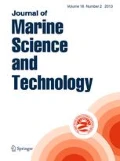Abstract
A supercavitation is a modern technology that can reduce the frictional resistance of an underwater vehicle. To reach supercavity, which is when the cavity envelops the entire vehicle body, a vehicle passes through the transition phase from fully wetted to supercavitating operation where unsteady hydrodynamic forces and moments are created by partial cavity. This paper presents analytical and numerical investigations into the dynamics of a supercavitating vehicle in the transition phase as well as a neural network-based adaptive control method that guarantees a stable control performance with modeling uncertainty. The ventilated cavity model is used for the rapid supercavity condition, which is when the cavitation number is relatively high. The cavity profile decides the immersion depths of the fins and body to calculate the hydrodynamical effects on the body. The supercavitating system in the transition phase is replaced by linearized pitch motion dynamics to verify the performance of the design controller. In addition, a numerical simulation shows how the proposed control method can compensate for modeling uncertainty.

















Similar content being viewed by others
References
Dzielski J, Kurdila A (2003) A benchmark control problem for supercavitating vehicles and an initial investigation of solutions. J Vib Control 9(7):791–804
Vanek B, Bokor J, Balas GJ, Arndt RE (2007) Longitudinal motion control of a high-speed supercavitation vehicle. J Vib Control 13(2):159–184
Dzielski JE (2011) Longitudinal stability of a supercavitating vehicle. IEEE J Oceanic Eng 36(4):562–570
Fan H, Zhang Y, Wang X (2011) Longitudinal dynamics modeling and MPC strategy for high-speed supercavitating vehicles. In: International conference on electric information and control engineering (ICEICE), 2011. IEEE, pp 5947–5950
Calise AJ, Lee S, Sharma M (2001) Development of a reconfigurable flight control law for tailless aircraft. J Guid Control Dyn 24(5):896–902
Kim N (2003) Improved methods in neural network-based adaptive output feedback control, with applications to flight control. Ph.D. dissertation, Georgia Tech., Atlanta, GA
Calise AJ, Hovakimyan N, Idan M (2001) Adaptive output feedback control of nonlinear systems using neural networks. Automatica 37(8):1201–1211
Egardt B (1979) Stability of adaptive controllers. Lecture notes in control and information sciences 20. Springer, Berlin
Peterson B, Narendra KS (1982) Bounded error adaptive control. IEEE Trans Autom Control 27(6):1161–1168
Ioannou PA (1983) Adaptive systems with reduced models. Lecture notes in control and information sciences
Ioannou PA, Kokotovic PV (1984) Instability analysis and improvement of robustness of adaptive control. Automatica 20(5):583–594
Narendra KS, Annaswamy AM (1987) A new adaptive law for robust adaptation without persistent excitation. IEEE Trans Autom Control 32(2):134–145
Narendra KS, Annaswamy AM (1989) Stable adaptive control, Chapter 8. Prentice Hall, Upper Saddle River
Naik SM, Kumar P, Ydstie BE (1992) Robust continuous-time adaptive control by parameter projection. IEEE Trans Autom Control 37(2):182–197
Pomet J-B, Praly L (1992) Adaptive nonlinear regulation: estimation from the Lyapunov equation. IEEE Trans Autom Control 37(6):729–740
Kim K et al (2013) Flight test of a flying-wing type UAV with partial wing loss using neural network controller. In: AIAA guidance, navigation, and control conference and exhibit, August 19–22, Boston, MA
Corban JE, Calise AJ, Prasad J, Hur J, Kim N (2002) Flight evaluation of adaptive high-bandwidth control methods for unmanned helicopters. In: AIAA guidance, navigation, and control conference and exhibit
Fujii T, Ura T (1991) SONCS: self-organizing neural-net-controller system for autonomous underwater robots. IEEE international joint conference on neural networks, 1991. IEEE, pp 1973–1982
Ishii K, Fujii T, Ura T (1995) An on-line adaptation method in a neural network based control system for AUVs. IEEE J Oceanic Eng 20(3):221–228
Ishii K, Ura T, Fujii T (1994) A feedforward neural network for identification and adaptive control of autonomous underwater vehicles. In: IEEE international conference on neural networks, 1994. IEEE world congress on computational intelligence. IEEE, pp 3216–3221
Fujii T et al (1993) Development of a versatile test-bed “Twin-Burger” toward realization of intelligent behaviors of autonomous underwater vehicles. OCEANS’93. In: Proceedings of the engineering in harmony with ocean, vol 181. IEEE, pp I186–I191
Varghese AN, Uhlman JS, Kirschner IN (2005) Numerical analysis of high-speed bodies in partially cavitating axisymmetric flow. J Fluids Eng 127(1):41–54
Ahn B-K, Lee T-K, Kim H-T, Lee C-S (2012) Experimental investigation of supercavitating flows. Int J Nav Archit Ocean Eng 4(2):123–131
Zou W, Yu K-P, Wan X-H (2010) Research on the gas-leakage rate of unsteady ventilated supercavity. J Hydrodyn Ser B 22(5):778–783
Xiang M, Cheung S, Tu J, Zhang W (2011) Numerical research on drag reduction by ventilated partial cavity based on two-fluid model. Ocean Eng 38(17):2023–2032
Elbing BR et al (2008) Bubble-induced skin-friction drag reduction and the abrupt transition to air-layer drag reduction. J Fluid Mech 612:201–236
Savchenko YN (1998) Investigation of high-speed supercavitating underwater motion of bodies. NASA (19980020552)
Logvinovich GV (1972) Hydrodynamics of free-boundary flows. Israel Program for Scientific Translations (IPST), Jerusalem, p 104
Garabedian P (1956) Calculation of axially symmetric cavities and jets. Pac J Math 6(4):611–684
May A (1975) Water entry and the cavity-running behavior of missiles. DTIC document
Kirschner IN, Kring DC, Stokes AW, Fine NE, Uhlman JS (2002) Control strategies for supercavitating vehicles. J Vib Control 8(2):219–242
Fine NE, Uhlman JS, Kring DC (2001) Calculation of the added mass and damping forces on supercavitating bodies. http://resolver.caltech.edu/cav2001:sessionB3.006
Waid RN (1957) Cavity shapes for circular disk at angle of attack. CIT hydrodynamics report E-73.4. California Institute of Technology, CA (as summarized in May, 1975)
Newman JN (1977) Marine hydrodynamics. MIT press, Cambridge
Logvinovich G, Serebryakov V (1975) On methods of calculating a shape of slender axisymmetric cavities. Gidromehanika 32:47–54
Author information
Authors and Affiliations
Corresponding author
About this article
Cite this article
Kim, S., Kim, N. Neural network-based adaptive control for a supercavitating vehicle in transition phase. J Mar Sci Technol 20, 454–466 (2015). https://doi.org/10.1007/s00773-014-0298-6
Received:
Accepted:
Published:
Issue Date:
DOI: https://doi.org/10.1007/s00773-014-0298-6



